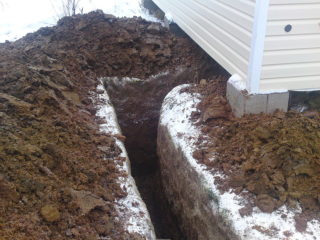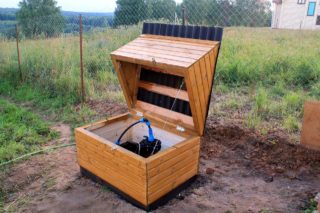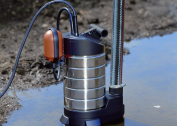For the full functioning of the seasonal suburban area, it is desirable to make winter water supply in the country. Then rest in the cold season will be comfortable. Mounting communication on your own is not difficult. The main thing is to know the basic principles of the system device.
Features of the installation of the highway
A winter water supply system is characterized by such features of its functioning:
- The cottage system must be equipped with equipment for its conservation. If the owners need to leave for a long time, the liquid simply drains from the pipes. This helps prevent freezing of the water supply.
- It is important to lay pipes only below the level of freezing of the soil or to make their quality insulation.
- When installing the line, it is important to observe the bias from the house to the source (well / well). This will ensure free runoff of water and protect pipes from stagnation.
- It is advisable to use a heating cable, which will additionally protect the water supply in the country from subzero temperatures.
Subject to all these rules, it is possible to make a non-freezing water supply in the country in 1-2 days.
Preparatory work
At the stage of preparation for installation, it is extremely important to draw up a plan diagram of the entire wiring. This will allow you to purchase the right footage of pipes and all necessary components (fittings, taps, adapters). The drawing points of the location of the pumping equipment, plumbing areas in the house are necessarily applied.
The preparation includes a digging of trenches for laying pipes. The channels are made wide enough so that it is possible to arrange layers of insulation in them.
It is also worth deciding on the type of source source - a well or a well. In favor of the first say the following advantages:
- lack of blockages with prolonged idle time of the source;
- for water injection, you can choose a more affordable surface or submersible pump, but not expensive deep;
- installation of a well is always several times cheaper than the installation of a well.
It is best to deal with the installation of a winter water supply system in summer or early fall, when the groundwater level is as low as possible.
Tools and materials
To lay a winter water supply in the country, you should prepare the following tools:
- bayonet shovel;
- a special soldering iron for polypropylene pipes (they are optimal for street waterways);
- roulette;
- hacksaw for cutting pipes;
- Screwdriver Set;
- sealant.
From materials should be prepared:
- Pump equipment. It is advisable to choose a surface centrifugal pump and immediately equip it with a hydraulic accumulator.
- The desired footage. It is better to take polypropylene. They are most inert to temperature extremes, aggressive environments, rodents, and corrosion.
- Drain valve. Provides drainage from the system. A drain valve is installed at the lower point of the water supply near the pump. It is advisable to take an electromagnetic element.
- Accumulator For a family of 3-4 people, a capacity of 25-50 liters is enough. A membrane tank helps maintain constant pressure in the line. Well, if the accumulator is equipped with a pressure switch. It is this element that is responsible for the on / off cycles of pumping equipment.
- Connecting fittings. They are selected by the number of turns of the highway.
- Stopcocks.
- Insulation (cable, polystyrene cylinders, mineral wool, etc.). It is needed if pipes cannot be laid below the level of soil freezing due to the features of the terrain or the composition of the soil - rocky rocks, etc.
When buying a tube, it is advisable to make a small supply - to purchase 10% more than the indicated footage. They will come in handy when making mistakes at the time of installation.
Installation Steps
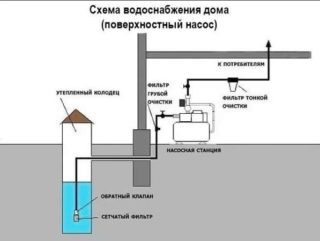 Work on the installation of a winter water supply system is carried out step by step:
Work on the installation of a winter water supply system is carried out step by step:
- Earthwork. The bottom of the prepared canal should be tamped and pour a sand cushion 10-15 cm thick on it. It is also compacted.
- Mount pumping equipment. It is advisable to install the unit in an insulated caisson and on a special concreted area. This will eliminate its vibration.
- The accumulator is connected to the pump. In this case, a pressure switch must be installed.
- A hose and pipes are connected to the inlet and outlet nozzles of the pump using fittings. The first is designed to draw water from the well. The second is the immediate start of the pipeline.
- Stretch the line from the pump to the house or bath. Pipe laying is carried out using a special soldering iron. To do this, one end of the pipe is inserted into the nozzle of the desired diameter. On the second part of the soldering iron put on the end of the connector. Withstand 3-5 seconds and join two elements. It is important to insert the pipe into the fitting and turn them slightly. The molten polymer binds well, forming a strong, tight connection.
- Insulate the pipes with the selected material. It is worthwhile to ensure that the insulation is laid without gaps and cold bridges. Otherwise, condensation will appear due to them, which will provoke freezing of the system. At the time of installation of the insulation, it is important to take care of its high-quality waterproofing or select a material that reacts inertly to water.
If mineral wool or polystyrene is used for insulation, it is advisable to cover them from above with a special coating of cement and broken glass. Otherwise, rodents, in search of heat, can gnaw material in the winter.
The last stage of the water supply device is its backfill. The soil is laid freely, without strong compaction. It is better to add soil later when it sags than to tamp the soil and put the entire system at risk of damage.
Common errors during the installation of water supply
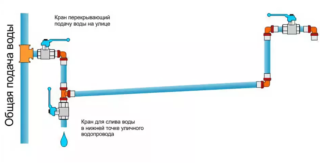 Often, inexperienced masters make a number of mistakes that later turn into big problems. The main ones are:
Often, inexperienced masters make a number of mistakes that later turn into big problems. The main ones are:
- Lack of a drain tap. Without it, the water supply of the cottage can not rightly be called winter. The lack of regular drainage of water provokes the risk of freezing of the line. This will sooner or later lead to its rupture.
- Lack of bias or its wrong direction. In the first case, the water will stagnate in the system, which can lead to its freezing. In the second embodiment, the liquid will drain not to the source, but to the house. With closed cranes, it will remain in that part of the highway, which is closer to the building, and here it will freeze at sub-zero temperatures.
- Using the wrong materials and equipment: incorrectly selected pipes, insufficiently efficient pump, etc. If the tube material is incorrect (steel, PVC), the line may burst, corrode, freeze. If the matter is in the pump, he simply will not supply the right amount of water to the family. Electricity will be consumed. The risk of burning equipment in such situations is high.
- Incorrect deepening of the line. If the master deduced inaccurate data on the level of soil freezing in the region, but did not use insulation to heat the system, most likely the line will freeze when the temperature drops in winter. To find out the exact level of soil freezing, it is advisable to use SNiP tables or simply view information on the Internet.
- Lack of blueprint communication. In the event of an emergency and in the absence of a trunk circuit, the master runs the risk of encountering serious problems. It is necessary to carry out a complete excavation of the pipeline to eliminate the breakdown.
Winter water supply in the country is the key to a comfortable stay in the country in any season, regardless of the weather.
